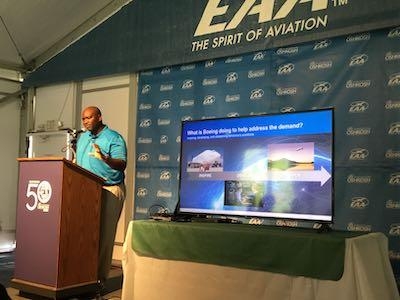Continued Growth And Demand For Pilots And Technicians Outpaces Supply
By Gary Risley
Boeing continues to predict a strong demand for new aircraft, pilots, and technicians through the year 2038. It anticipates that the airlines will need 44,000 new airplanes, valued at $6.8 trillion, during this timeframe, and that demand for pilots will grow at the rate of 40,000 per year and technicians at the rate of 38,000 per year worldwide.

William Ampofo (pictured), vice president of business aviation and general aviation at Boeing, stated that Boeing predicts that 40% of future airplane demand will come from the Asia Pacific area.
Air travel continues to grow, consumer spending worldwide is climbing, and cities around the world, particularly in Asia, continue to grow rapidly. Load factors for airlines are currently 80% and above, and extra capacity is needed to meet the demand created by the growing cities. New aircraft produced to meet this demand will need to incorporate new technologies for the convenience of the passengers and to make the aircraft more efficient in both operations and maintenance. It is predicted that aircraft will become flying data centers and that the data available to maintenance staff and technicians will increase by 100 percent in the coming years.
Aircraft will also need to develop connectivity for the benefit and expectations of the passengers on the aircraft. Connectivity is a high demand need in the business aircraft market where executives desire to be able to continue to work and communicate with staff while in route to their destination. No details of how the connectivity goal can be met were provided.
Boeing has been expanding its horizons to assist with developing and providing the pilots and technicians that will be needed for the future. Their concept of training is addressed as three aspects: 1 Blended; 2. Personalized; 3. Integrated. Blended training is viewed as a combination of theory and practical applications. Personalized training is focused on obtaining personalized data about the student so that strengths and weaknesses can be identified and addressed during the training process. Integrated training is process that allows an already licensed pilots to enroll in a multi-pilot license program that would take them through various commercial ratings or type ratings, and the integrated program that would take them through their ATP ratings. The ab initio program incorporates these concepts.
Increased demand for pilots is represented by the fact that the regional airlines pay for pilots has doubled over the past several years. The pay for certified flight instructors has also increased dramatically.
On the technician side of the demand prediction, it is it is anticipated that commercial aviation will require over $9.1 trillion in services over the next 20 years. Ground and cargo operations constitute about $4.8 billion of the anticipated demand, maintenance and engineering constitutes $2.4 billion of the anticipated demand, and flight operations is anticipated to require $1.17 billion worth of services through 2038. The balance of 4.8 trillion is related to corporate and external services, and marketing and planning.
To supply the services that are needed, it is the estimated that the world will require 769,000 technicians by 2038. 632,000 of these technicians will be working in the commercial area, 93,000 of them will be working in the business area, and 44,000 will be needed for helicopters, according to the forecast.
Boeing sees the biggest challenges to meeting the demand are attracting and retaining talent. Training availability and affordability continue to be issues, worldwide competition for the talent that has been trained and available are being "poached" by carriers in countries outside the U.S., and technological advances create some doubt as to the exact nature of staffing that will be needed or the aptitude that might be needed to run the technology. With 38% of the current maintenance personnel reaching retirement age in the next 10 years along with approximately 35% of professional pilots reaching mandatory retirement in the next 10 years, the need to fill both the coming vacancies and the growing demand is significant.
Political and regulatory issues play a part in creating the shortage. The 1500 hour rule that is statutory in the US for first officers on scheduled aircraft which operate with more than 19 seats makes it difficult for lower time pilots to obtain the necessary hours to become ATPs. There are few avenues for building hours left other than being a certified flight instructor. Boeing is working with NBAA and other industry groups concerning this issue, but a resolution has not yet been reached.
Boeing is also working in cooperation with industry groups and the regulatory agencies to advance the use of technologies, such as flight simulation and virtual reality, to reduce the cost of flight training and to introduce the pilot to scenarios that he or she might not face due to the local training environment or which would not be safe to attempt an actual aircraft.
To further help address the issue of affordability and availability of training, Boeing is giving grants to colleges and high schools to enhance their STEM programs and has given Embry Riddle $3 million to assist with scholarships. They also host career days to expose young people to the career opportunities in aviation and encourage them to explore those opportunities.
(Images provided by author. Pictured: William Ampofo, Boeing vice president, Business Aviation & General Aviation)
 Airbus Racer Helicopter Demonstrator First Flight Part of Clean Sky 2 Initiative
Airbus Racer Helicopter Demonstrator First Flight Part of Clean Sky 2 Initiative Diamond's Electric DA40 Finds Fans at Dübendorf
Diamond's Electric DA40 Finds Fans at Dübendorf ANN's Daily Aero-Term (04.23.24): Line Up And Wait (LUAW)
ANN's Daily Aero-Term (04.23.24): Line Up And Wait (LUAW) NTSB Final Report: Extra Flugzeugbau GMBH EA300/L
NTSB Final Report: Extra Flugzeugbau GMBH EA300/L Classic Aero-TV: 'Never Give Up' - Advice From Two of FedEx's Female Captains
Classic Aero-TV: 'Never Give Up' - Advice From Two of FedEx's Female Captains



